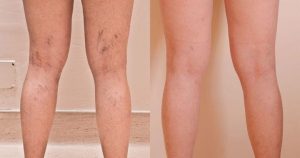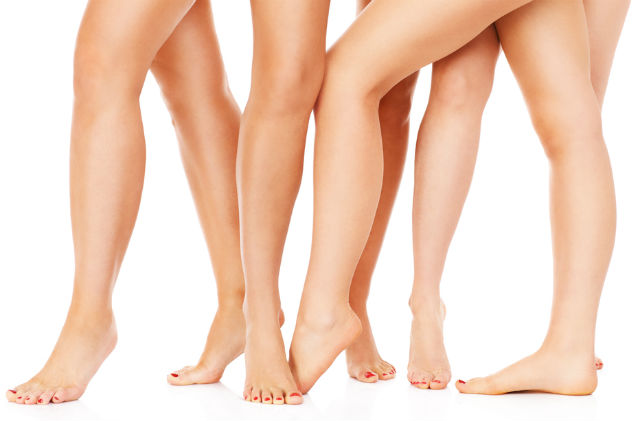Many people think varicose veins are caused by standing too long, or are due to extreme exercise, or that they just develop as a part of old age. Actually, varicose veins are caused by a disease in the major leg vein at the top of the leg which is called the greater saphenous vein.
Sclerotherapy
Sclerotherapy involves an injection of a solution (generally a salt solution) directly into the vein. The solution irritates the lining of the blood vessel, causing it to collapse and stick together and the blood to clot.
Phlebectomy
Phlebectomy is a minimally-invasive surgical procedure that removes surface varicose veins. There are two basic types of phlebectomy: Ambulatory and Transilluminated Powered Phlebectomy (TIPP).
Ambulatory Phlebectomy
An ambulatory phlebectomy is usually performed in a doctor’s office using local anesthesia. First, a local anesthetic fluid is injected into the area of varicose vein clusters to be treated. The doctor then uses a small scalpel or needle to puncture the skin next to the varicose vein, inserts a small hook into the hole, grasps the vein and removes it. The area is covered with a compression bandage and/or compression stockings. No stitches are required and the scars are nearly imperceptible. The patient is able to walk immediately following the procedure, which is often performed following the VenaCure EVLT™ procedure to remove any large surface veins left behind after the procedure. The possible risks of ambulatory phlebectomy include an allergic reaction to the anesthetic and localized numbness.


The VenaCure EVLT Endovenous Laser System
The VenaCure EVLT procedure treats the source of unsightly varicose veins with no hospital stay, minimal-to-no scarring, no lengthy recovery and minimal-to-no side effects. In less than an hour, you can be free from bulging, twisted varicose veins and back to enjoying your everyday activities. The VenaCure EVLT procedure is safe, fast, and effective.
- Treatment in less than an hour.
- Can be performed in the doctor’s office.
- Up to 98% success rate.
- Immediate relief of symptoms.
- Return to normal activity immediately – with little or no pain.
- No general anesthesia or hospitalization.
- Minimal-to-no scarring.
- Typically is covered by insurance.
Here’s what to expect from the VenaCure EVLT procedure:
- Your doctor uses ultrasound to map out your vein.
- Local anesthetic is applied.
- A thin laser fiber is inserted through a tiny entry point, usually near the knee.
- Laser energy is delivered to seal the faulty vein.
- Walking immediately after the procedure is encouraged. Normal daily activity can be resumed; just avoid rigorous activities such as gym workouts.
- There may be minor soreness and bruising. Any discomfort can be treated with over-the-counter, non-aspirin pain relievers as necessary.
Endovenous Laser Treatment
Endovenous Laser Treatment for the elimination of varicose veins is quickly becoming the gold-standard in the treatment of varicose veins. Endovenous Laser Treatment uses laser energy, which is simply a highly concentrated beam of light. Medical lasers work by delivering this light energy to the targeted tissue with extreme precision, so as not to affect the surrounding tissue. Lasers have proven their safety and effectiveness through years of use in all types of medical procedures, from eye surgery to dermatology. In the hands of a skilled physician, lasers offer far less risk for complications than conventional surgery.
In endovenous laser treatment, a thin fiber is inserted into the damaged vein through a very small entry point in the skin. A laser light is emitted through the fiber, as the fiber is pulled back through the vein, it delivers just the right amount of energy. The targeted tissue reacts with the light energy, causing the vein to close and seal shut. The veins that are closed are superficial veins that handle less than five percent of the body’s blood flow. The blood is automatically routed to other, healthy veins.
Some physicians are now using a jacketed fiber, which prevents any contact between the fiber and the vein wall. This prevents much of the pain and bruising that is often associated with the more conventional method of ligation and stripping. Some patients may experience temporary soreness or some slight swelling, which can be treated effectively with over-the-counter, non-aspirin pain relievers and typically subsides within the first five days.
The procedure is minimally invasive and requires no general anesthesia. Only local anesthetic is used to numb the area where the physician is working. Patients are encouraged to walk immediately after the procedure and can resume normal activities the same day.
The VenaCure EVLT™ system utilizes this technology and method to eliminate varicose veins. Learn more about the VenaCure EVLT procedure.

